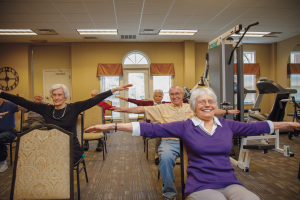Fall prevention can be an uncomfortable topic to consider as your loved ones get older. The fear of falling does not need to overwhelm you or your loved ones. Although falls are the leading cause of injury among seniors, there are simple fall prevention strategies by the Mayo Clinic to consider and reduce the risk for your loved one.
Make an appointment with your health care provider
Be prepared to discuss the following at your next appointment.
- Your medications. Make a list of your prescription and nonprescription medications and supplements, or bring them with you to the appointment. Your health care provider can review your medications for side effects and interactions that may increase your risk of falling. To help with fall prevention, your health care provider may consider weaning you off medications that make you tired or affect your thinking, such as sedatives, antihistamines and some types of antidepressants.
- Any previous falls. Write down the details, including when, where and how you fell. Be prepared to discuss instances when you almost fell but were caught by someone or managed to grab hold of something just in time. Details such as these may help your health care provider identify specific fall prevention strategies.
- Your health conditions. Certain eye and ear disorders may increase your risk of falls. Be prepared to discuss your health conditions and how comfortable you are when you walk — for example, do you feel any dizziness, joint pain, shortness of breath, or numbness in your feet and legs when you walk? Your health care provider may evaluate your muscle strength, balance and walking style (gait) as well.
Keep moving
Physical activity such as walking, water workouts, yoga, or tai chi can make great impacts with fall prevention. Please get your health care provider’s approval for a gentle exercise activities. These activities improve balance, strength, flexibility, and coordination.
If you have tried physical activity and fear falling, please let your health care provider know. They may refer you to physical therapy. Our physical therapists can create custom exercise programs to improve your muscle strength, balance, and coordination.
Finding a different type of shoe may be part of your fall prevention plan. High heels, backless slippers and slick soles can make you slip, stumble and fall. Look for properly fitting, sturdy, flat shoes with nonskid soles.
Remove home hazards
Here are some quick tips to make your home safer:
- Remove boxes, newspapers, electrical cords and phone cords from walkways.
- Move coffee tables, magazine racks and plant stands from high-traffic areas.
- Secure loose rugs with double-faced tape, tacks or a slip-resistant backing — or remove loose rugs from your home.
- Repair loose, wooden floorboards and carpeting right away.
- Store clothing, dishes, food and other necessities within easy reach.
- Immediately clean spilled liquids, grease or food.
- Use nonslip mats in your bathtub or shower. Use a bath seat, which allows you to sit while showering.
Light up your living space
Keep your home brightly lit to avoid tripping on objects that are hard to see.
- Place night lights in your bedroom, bathroom and hallways.
- Place a lamp within reach of your bed in case you need to get up in the middle of the night.
- Make clear paths to light switches that aren’t near room entrances. Consider trading traditional switches for glow-in-the-dark or illuminated switches.
- Turn on the lights before going up or down stairs.
- Store flashlights in easy-to-find places in case of power outages.
Use assistive devices
Your health care provider might recommend using a cane or walker to keep you steady. Other assistive devices can help, too. For example:
- Handrails for both sides of stairways
- Nonslip treads for bare-wood steps
- A raised toilet seat or one with armrests
- Grab bars for the shower or tub
- A sturdy plastic seat for the shower or tub — plus a hand-held shower nozzle for bathing while sitting down
If you have any questions about reducing fall risks in your loved one’s home , please ask one of our therapy team members. We are happy to help!

